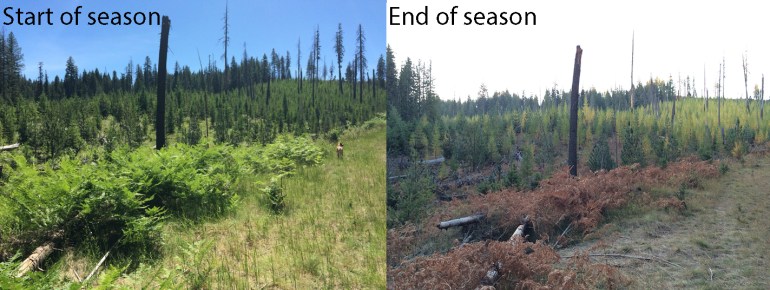As trees photosynthesize, using carbon from the atmosphere to grow and store energy, they also lose water to the air (transpire). During a drought, continuing to photosynthesize and transpire puts trees at risk of damaging their hydraulic conductivity and overall health. With growing seasons expected to lengthen with climate change in the northwestern USA, the mixed conifer forests that dominate this region will experience extended seasonal drought conditions and more frequent extreme drought events. Already the effects are beginning to be felt, with 2015 experiencing the most extreme drought for the area on record.

In a recent article published in AoBP, Baker et al. studied trees during the record-breaking 2015 drought to understand how mixed conifer forests in northern Idaho will fare under future extended seasonal drought conditions. Daily courses of water potential and leaf gas exchange, as well as the hydraulic conductivity and vulnerability to embolism of six dominant native conifer species were measured across 5 months. All six conifer species changed their hydraulic strategies in response to the drought conditions. They regulated their water use in response both to how dry the air was (vapor pressure deficit) and to how dry the leaves themselves became (leaf water potential) after two months without rainfall. Despite the severity of this drought, all species were also able to continue photosynthesis until mid-October, the end of the growing season, likely due to the mediating effects of the meter-deep, ash-capped silty-loam soils with large water storage capacity. The results of this study suggest that the future prospects are good for these forests, with the authors stating that these fertile soiled ecosystems could act as refugia under extreme drought events.
Researcher highlight
Kathryn V. Baker is currently a Visiting Professor in Environmental Science at Marist College in New York, USA. Having been introduced to the world of forest ecology and physiology in the Rocky Mountains as a Biology undergraduate at Colorado College, she received her PhD from the University of Idaho in the summer of 2019 with Professor Daniel M. Johnson.
Kathryn’s research focuses on tree hydraulics in drought and how they can change across seasons. She is interested in what conditions and mechanisms drive dynamic water use behavior and using ecophysiological field data to inform predictions of forest growth, mortality, and resilience under climate change.





